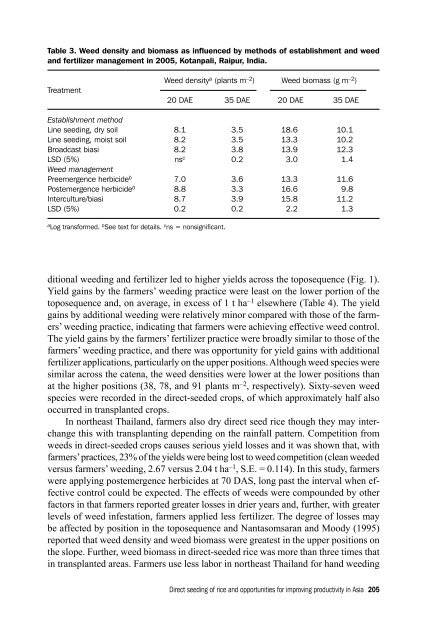Download (2461kB) - University of Greenwich
Download (2461kB) - University of Greenwich
Download (2461kB) - University of Greenwich
- No tags were found...
You also want an ePaper? Increase the reach of your titles
YUMPU automatically turns print PDFs into web optimized ePapers that Google loves.
Table 3. Weed density and biomass as influenced by methods <strong>of</strong> establishment and weedand fertilizer management in 2005, Kotanpali, Raipur, India.TreatmentWeed density a (plants m –2 ) Weed biomass (g m –2 )20 DAE 35 DAE 20 DAE 35 DAEEstablishment methodLine seeding, dry soil 8.1 3.5 18.6 10.1Line seeding, moist soil 8.2 3.5 13.3 10.2Broadcast biasi 8.2 3.8 13.9 12.3LSD (5%) ns c 0.2 3.0 1.4Weed managementPreemergence herbicide b 7.0 3.6 13.3 11.6Postemergence herbicide b 8.8 3.3 16.6 9.8Interculture/biasi 8.7 3.9 15.8 11.2LSD (5%) 0.2 0.2 2.2 1.3a Log transformed. b See text for details. c ns = nonsignificant.ditional weeding and fertilizer led to higher yields across the toposequence (Fig. 1).Yield gains by the farmers’ weeding practice were least on the lower portion <strong>of</strong> thetoposequence and, on average, in excess <strong>of</strong> 1 t ha –1 elsewhere (Table 4). The yieldgains by additional weeding were relatively minor compared with those <strong>of</strong> the farmers’weeding practice, indicating that farmers were achieving effective weed control.The yield gains by the farmers’ fertilizer practice were broadly similar to those <strong>of</strong> thefarmers’ weeding practice, and there was opportunity for yield gains with additionalfertilizer applications, particularly on the upper positions. Although weed species weresimilar across the catena, the weed densities were lower at the lower positions thanat the higher positions (38, 78, and 91 plants m –2 , respectively). Sixty-seven weedspecies were recorded in the direct-seeded crops, <strong>of</strong> which approximately half alsooccurred in transplanted crops.In northeast Thailand, farmers also dry direct seed rice though they may interchangethis with transplanting depending on the rainfall pattern. Competition fromweeds in direct-seeded crops causes serious yield losses and it was shown that, withfarmers’ practices, 23% <strong>of</strong> the yields were being lost to weed competition (clean weededversus farmers’ weeding, 2.67 versus 2.04 t ha –1 , S.E. = 0.114). In this study, farmerswere applying postemergence herbicides at 70 DAS, long past the interval when effectivecontrol could be expected. The effects <strong>of</strong> weeds were compounded by otherfactors in that farmers reported greater losses in drier years and, further, with greaterlevels <strong>of</strong> weed infestation, farmers applied less fertilizer. The degree <strong>of</strong> losses maybe affected by position in the toposequence and Nantasomsaran and Moody (1995)reported that weed density and weed biomass were greatest in the upper positions onthe slope. Further, weed biomass in direct-seeded rice was more than three times thatin transplanted areas. Farmers use less labor in northeast Thailand for hand weedingDirect seeding <strong>of</strong> rice and opportunities for improving productivity in Asia 205
















